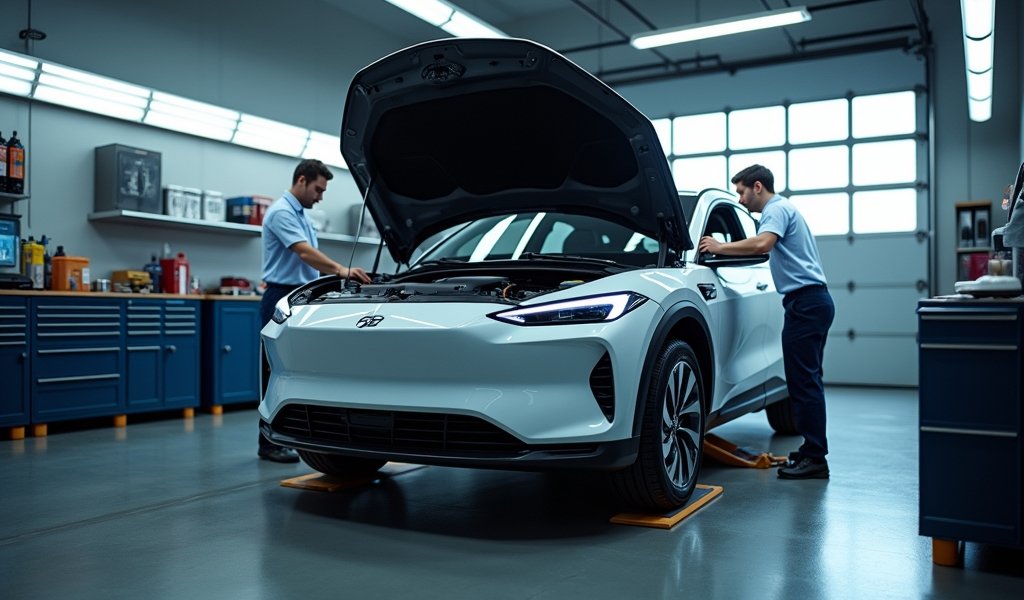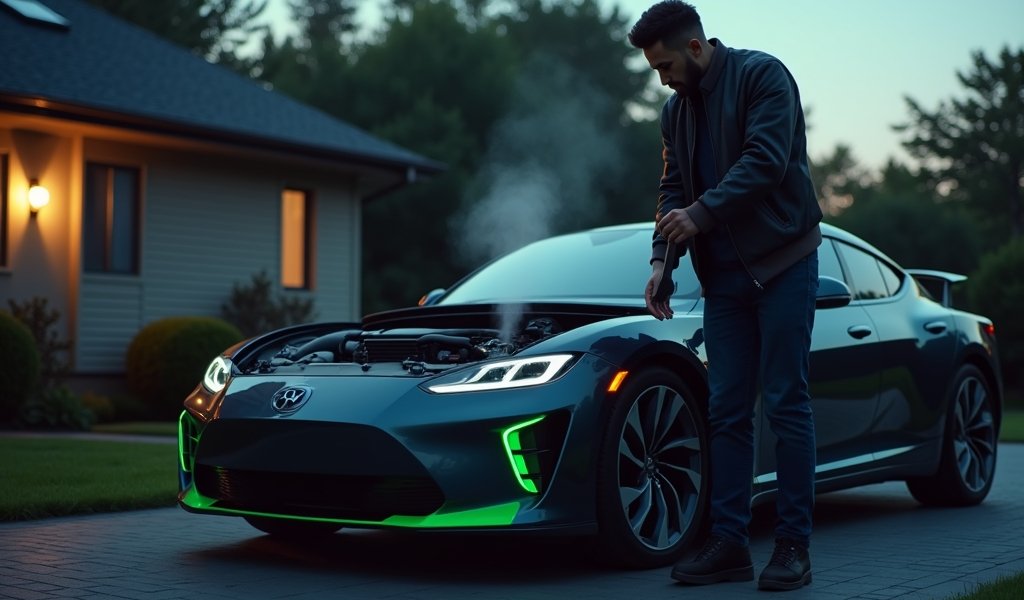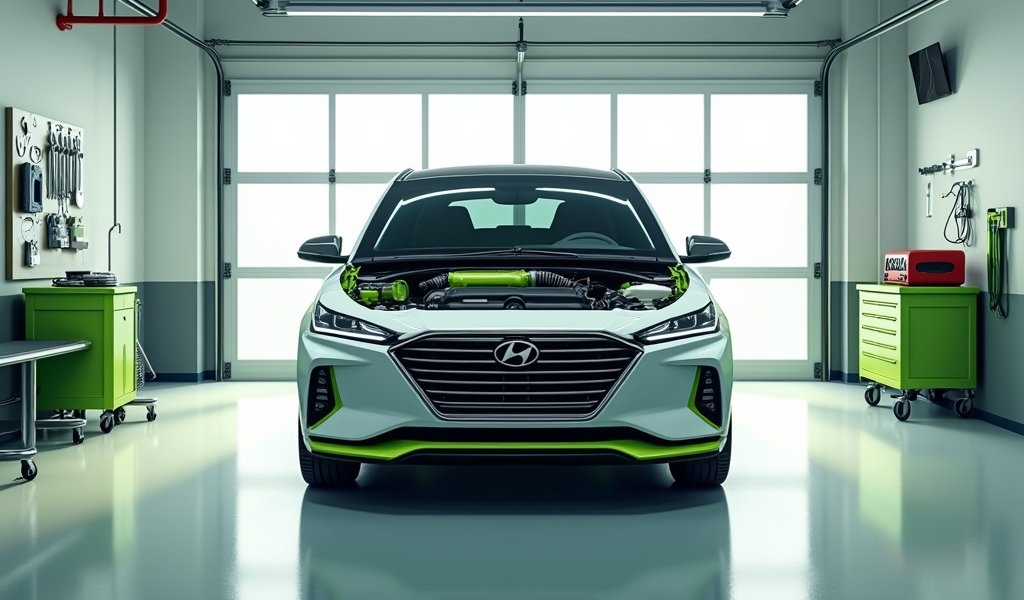Overview
This hybrid car maintenance guide covers seven essential aspects of hybrid care, including battery maintenance, regenerative braking systems, cooling systems, tire care, engine maintenance, and using onboard monitoring effectively. The article emphasizes that proper, consistent maintenance helps extend vehicle life, preserve efficiency, and save money on repairs, with specific advice for each system from an experienced mechanic.
Table of Contents
- Introduction to Hybrid Car Maintenance
- Regular Service Schedules: The Foundation of Hybrid Care
- Battery Care: Protecting Your Hybrid’s Heart
- Regenerative Braking System Maintenance
- Cooling System Care for Hybrid Components
- Tire Maintenance: Optimizing Efficiency and Safety
- Conventional Engine Care in Hybrid Vehicles
- Using Onboard Monitoring Systems Effectively
- Conclusion
- Frequently Asked Questions
Introduction to Hybrid Car Maintenance
As a mechanic with over 15 years of experience working on hybrid vehicles, I’ve seen firsthand how proper maintenance can extend the life of these innovative machines. A comprehensive hybrid car maintenance guide is essential for owners who want to maximize their investment and keep their vehicles running efficiently. Hybrids combine conventional engines with electric motors, creating unique maintenance needs that differ from traditional vehicles.
The good news? Maintaining a hybrid isn’t rocket science. In fact, with the right knowledge and a proactive approach, you can save thousands on repairs and enjoy better performance. According to a study by Consumer Reports, well-maintained hybrids typically retain their fuel efficiency advantages longer than poorly maintained ones—sometimes up to 15% better over five years.
In this guide, I’ll walk you through the seven most critical aspects of hybrid maintenance, providing practical tips that you can implement regardless of your mechanical expertise. Whether you drive a Toyota Prius, Honda Insight, or any other hybrid model, these principles apply universally. Let’s dive into the world of hybrid maintenance with clear, actionable advice.
Regular Service Schedules: The Foundation of Hybrid Care
The cornerstone of effective hybrid maintenance is adhering to your manufacturer’s recommended service schedule. Unlike what some might tell you, hybrids aren’t maintenance-free—they just have different needs. Your owner’s manual is gold here, folks. It contains specific intervals for fluid changes, inspections, and component replacements tailored to your exact vehicle.
What makes hybrid service schedules unique? For starters, many hybrids can go longer between oil changes—typically 5,000 to 10,000 miles instead of the traditional 3,000. This isn’t negligence; it’s by design. Hybrid engines often run less frequently and under reduced stress compared to conventional engines, resulting in slower oil degradation.
Here’s my practical advice: create a digital or physical maintenance log and follow it religiously. Tools like Knows Your Car can help track your maintenance schedule and send reminders when service is due. I’ve seen countless hybrid owners save thousands by simply following their service intervals correctly. One of my customers, Sarah, extended her Prius battery life to 12 years simply by never missing a scheduled check-up.
Don’t fall for the myth that dealerships are your only option for hybrid service. Many independent shops now have hybrid-certified technicians. The key is finding a mechanic who understands the dual nature of your vehicle’s powertrain and has access to the right diagnostic tools. Ask about their hybrid experience before entrusting your vehicle to them.

Battery Care: Protecting Your Hybrid’s Heart
The hybrid battery pack is undoubtedly the most distinctive component of your vehicle—and often the most misunderstood. Modern hybrid batteries are designed to last the lifetime of the vehicle, with many manufacturers offering 8-10 year warranties. However, proper care can extend their life well beyond these guarantees.
Temperature management is crucial for battery health. Extreme heat is the enemy of hybrid batteries, which is why most systems include dedicated cooling mechanisms. Park in shaded areas whenever possible during hot weather, and use covered parking garages for extended periods. Conversely, in extremely cold climates, try to garage your vehicle overnight.
Driving habits significantly impact battery longevity. Short trips with frequent starts and stops are actually ideal for hybrids, as they allow the regenerative braking system to recharge the battery efficiently. Extended periods of disuse, however, can be problematic. If you won’t be driving your hybrid for more than a couple of weeks, consider having someone take it for a 20-minute drive every week to maintain battery charge levels.
A common misconception I hear in my shop is that hybrid batteries need to be “run down” completely to prevent “memory effect.” This is outdated information from the nickel-cadmium battery era. Modern lithium-ion and nickel-metal hydride batteries used in today’s hybrids actually prefer partial discharge cycles. According to Department of Energy research, maintaining a charge between 20% and 80% is ideal for longevity.
Using tools like Knows Your Car’s battery health monitor can help you track degradation over time and identify potential issues before they become expensive problems. Many of my customers appreciate the early warning signs these systems provide, often saving them from roadside emergencies.
Regenerative Braking System Maintenance
One of the most ingenious features of hybrid vehicles is their regenerative braking system. Unlike conventional vehicles that convert kinetic energy to heat during braking (essentially wasting it), hybrids capture this energy and convert it back into electricity to recharge the battery. This not only improves efficiency but typically results in less wear on your brake pads and rotors.
Don’t be surprised if your hybrid’s brake pads last twice as long as those in your previous conventional vehicle. I’ve seen Toyota Prius models go 75,000 miles or more on their original brake pads. However, this extended lifespan creates a unique maintenance consideration: brake fluid flushes become relatively more important than pad replacements.
Brake fluid is hygroscopic, meaning it absorbs moisture from the air over time. This happens regardless of how often you use your brakes. Water-contaminated brake fluid has a lower boiling point and can cause brake fade or even failure under heavy use. For hybrid vehicles, I recommend having your brake fluid tested annually and flushed every 2-3 years regardless of mileage.
Another aspect of hybrid brake maintenance that’s often overlooked is caliper service. Because the friction brakes are used less frequently, the calipers can become sticky or even seize from lack of movement. A good practice is to occasionally use your conventional brakes with moderate pressure. Try this simple exercise: once a month, find a safe, empty road and perform a few moderate-speed stops (from about 30 mph to zero) using the brake pedal firmly. This helps keep the calipers moving freely and prevents rust buildup.
When it is time for brake service, consider using specialized electric vehicle maintenance techniques adapted for hybrids. The regenerative braking systems have specific service procedures that differ from conventional vehicles. Always make sure your mechanic is familiar with your hybrid model’s braking system—improper service can affect both safety and the efficiency of your regenerative system.
Cooling System Care for Hybrid Components
Hybrid vehicles often have two separate cooling systems: one for the internal combustion engine (similar to conventional vehicles) and another for the electric drive components. Maintaining both systems is crucial for longevity and efficiency. The cooling system for the electric components is particularly important as it prevents the battery pack and power electronics from overheating during operation.
Check your coolant levels monthly, but remember—many hybrids use specific coolant formulations for their electric systems. Using the wrong coolant can cause serious damage to expensive components. Always refer to your owner’s manual or consult with a hybrid-certified technician before adding or replacing coolant.
Radiator and cooling system flushes should follow manufacturer recommendations, typically every 50,000-100,000 miles. However, in hot climates or under heavy usage conditions, more frequent service may be beneficial. During these services, have your technician inspect all cooling system hoses, particularly those running to and from the hybrid components, as these can degrade over time.
The cooling system also includes fans and air intakes that keep the battery pack and electronics at optimal temperature. Keep the air intakes clean and free of debris. In some models, these intakes are located in the cabin or trunk area—check your owner’s manual for their exact location. A clogged intake can lead to reduced cooling efficiency and potentially shorten the life of your hybrid battery.
Monitoring tools like those offered by Knows Your Car can help track temperature patterns in your hybrid system. Unusual temperature fluctuations or consistently high readings could indicate cooling system issues that need attention. Catching these problems early can prevent costly component failures down the road.

Tire Maintenance: Optimizing Efficiency and Safety
Tire maintenance is critical for any vehicle, but for hybrids, it takes on an additional dimension: fuel efficiency. Many hybrids come equipped with low-rolling-resistance tires specifically designed to reduce energy consumption. Maintaining these tires properly can significantly impact your vehicle’s efficiency and overall performance.
Proper inflation is the single most important aspect of tire maintenance. Under-inflated tires create more rolling resistance, forcing your hybrid to use more energy to move. This translates directly to reduced fuel economy and increased emissions. Check your tire pressure monthly, and always when the tires are cold (before driving). The recommended pressure can be found on a sticker inside the driver’s door jamb or in your owner’s manual—not on the tire sidewall, which shows maximum pressure, not recommended pressure.
Rotation is equally important for even wear and maximum tire life. I recommend rotating your tires every 5,000-7,000 miles. Many of my customers coordinate this with their oil changes for convenience. During rotation, have your technician check for uneven wear patterns that might indicate alignment issues. Proper alignment is particularly important for hybrids, as misalignment increases rolling resistance and reduces efficiency.
When it’s time to replace your tires, consider sticking with low-rolling-resistance options. While they sometimes cost more initially, the fuel savings over the life of the tires often offsets the price difference. According to U.S. Department of Energy data, proper tire selection and maintenance can improve fuel economy by up to 3%—nothing to sneeze at when you’re already driving an efficient vehicle.
One tire-related tip specific to hybrid owners: pay attention to your tire tread depth. As tread wears down, rolling resistance actually decreases (which is why race cars use slick tires). However, wet traction suffers significantly. With the instant torque available from electric motors in hybrids, adequate traction is important for safety. Replace your tires when tread depth reaches 4/32″ for optimal balance between efficiency and safety.
Conventional Engine Care in Hybrid Vehicles
While the electric components often get all the attention, let’s not forget that your hybrid still has a conventional internal combustion engine that needs regular care. In fact, the intermittent operation pattern of hybrid engines creates some unique maintenance considerations.
Oil changes remain essential, though the intervals are typically longer than in conventional vehicles. Because the engine in a hybrid often shuts off during idle and low-speed operation, it actually accumulates fewer running hours per mile driven. Follow your manufacturer’s recommended oil change schedule, which is usually based on both time and mileage. Using the specified grade and type of oil is crucial—many hybrids require specific low-viscosity, energy-conserving formulations.
The less frequent use of the combustion engine in hybrids can sometimes lead to fuel system issues. Gasoline is perishable and can degrade over time, forming gummy deposits in the fuel system. If you frequently take only short trips where the engine barely runs, consider taking a longer 20-30 minute highway drive monthly to ensure the engine reaches full operating temperature and burns through a tank of gas every month or two.
Spark plugs, air filters, and fuel filters generally last longer in hybrids due to reduced engine operation, but they shouldn’t be neglected. When these components do need replacement, consider using OEM or equivalent parts specifically designed for hybrid applications. The engine in your hybrid is often optimized differently than its conventional counterparts, running at different RPM ranges and load conditions.
Another engine-related component that deserves attention is the starter system. Many hybrids use the electric motor as the starter, but some models have a conventional starter for initial engine starts. This starter may be used infrequently but still needs to function reliably. Regular electrical system checks should include verifying starter health.
Emission system components like oxygen sensors and catalytic converters are particularly important in hybrids. Because these vehicles are designed with environmental benefits in mind, maintaining proper emissions performance is part of that mission. Have your emission system checked according to manufacturer guidelines or if you notice any change in fuel economy or performance.
Using Onboard Monitoring Systems Effectively
Modern hybrids come equipped with sophisticated onboard diagnostic and monitoring systems that provide valuable insights into vehicle health and performance. Learning to interpret this information can transform how you maintain your vehicle. Think of it as having a mechanic riding along with you, constantly checking vital signs.
The energy flow display, common in most hybrids, shows real-time information about power distribution between the engine, electric motor, and regenerative braking system. This isn’t just a cool graphic—it’s a valuable tool for developing efficient driving habits. By observing how your driving style affects energy flow, you can adjust to maximize electric mode operation and reduce fuel consumption.
Pay attention to any hybrid system warnings or check engine lights. Unlike conventional vehicles where you might safely ignore a check engine light for a while (though I never recommend this), hybrid warning lights often indicate issues that could affect both performance and component longevity. Using a tool like Knows Your Car can help translate these warnings into actionable information before visiting a mechanic.
Battery health indicators are particularly useful. Most hybrids display state of charge, but some also show overall battery health or capacity over time. Gradual capacity reduction is normal, but sudden changes warrant investigation. Keep track of these readings periodically—perhaps monthly—to establish a baseline for your vehicle.
Fuel economy tracking is another valuable monitoring feature. Sudden drops in efficiency that persist across multiple tanks of gas can indicate mechanical problems developing. Seasonal variations are normal (expect 10-20% lower fuel economy in winter), but significant changes within the same season should prompt a closer look.
For the tech-savvy hybrid owner, consider investing in an OBD-II scanner compatible with hybrid systems. These devices provide deeper access to your vehicle’s monitoring systems than the dashboard displays alone. Some advanced scanners can even track hybrid-specific metrics like individual battery cell voltages, giving you unprecedented insight into your vehicle’s condition.
Conclusion
Maintaining a hybrid vehicle doesn’t have to be intimidating or overly complex. By following this hybrid car maintenance guide, you’ll not only extend the life of your vehicle but also preserve its efficiency advantages and environmental benefits. Remember that hybrids combine conventional and electric technologies, each with specific care requirements that, when addressed properly, result in exceptional longevity.
The key takeaway is consistency. Regular maintenance according to manufacturer schedules, attentive battery care, proper tire maintenance, and utilizing your vehicle’s monitoring systems will keep your hybrid performing optimally for years to come. Tools like Knows Your Car can simplify this process by tracking maintenance schedules and providing early warnings of developing issues.
As hybrid technology continues to evolve, staying informed about best practices for your specific model is valuable. Join owner forums, consult with hybrid-certified mechanics, and consider professional inspections annually even if no specific services are due. This proactive approach can identify potential problems before they become costly repairs.
With proper care, your hybrid vehicle can deliver hundreds of thousands of miles of efficient, environmentally friendlier transportation. The investment in regular maintenance pays dividends in reduced operating costs, fewer major repairs, and a vehicle that maintains its value better over time. Your hybrid was designed to be a long-term transportation solution—give it the care it deserves, and it will serve you well for many years to come.
Frequently Asked Questions
How often should I change the oil in my hybrid car?
Most hybrid vehicles require oil changes every 5,000-10,000 miles, longer than conventional vehicles. Always follow your manufacturer’s specific recommendations in your owner’s manual, as intervals vary by model.
Do hybrid batteries need special maintenance?
Hybrid batteries don’t require regular maintenance but benefit from proper driving habits and temperature management. Avoid extreme temperatures when parking and drive the vehicle regularly to maintain optimal battery condition.
Are hybrid cars more expensive to maintain than regular cars?
Routine maintenance costs for hybrids are comparable to conventional vehicles, and they often have lower brake replacement costs. While specialized repairs may cost more, overall maintenance expenses are typically similar or lower over the vehicle’s lifetime.
Can I take my hybrid to any mechanic for service?
While basic maintenance can be performed by most mechanics, hybrid-specific systems should be serviced by technicians with hybrid certification or training. Look for shops with hybrid experience or dealer service centers for specialized repairs.
How long do hybrid batteries typically last?
Most modern hybrid batteries last 150,000-200,000 miles or 10-15 years under normal conditions. Many manufacturers offer 8-10 year warranties on hybrid battery systems, and with proper care, they often exceed these timeframes.

